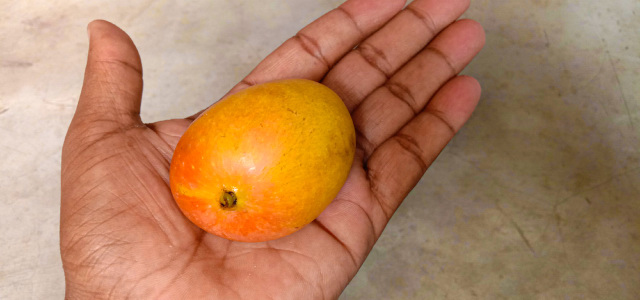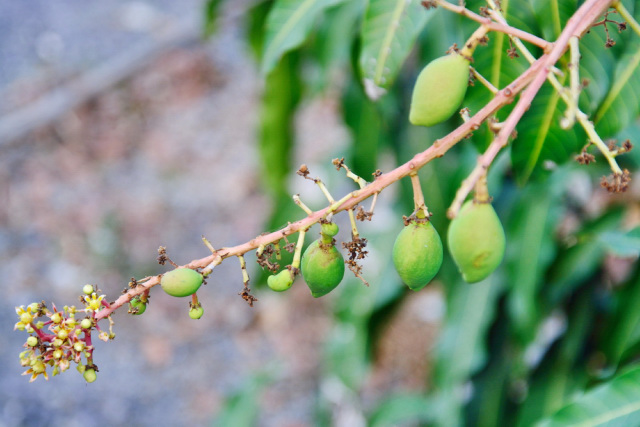If you grow mangoes, it’s likely that you want these delicious, tropical fruits to grow as big and juicy as possible. So if your mangoes are on the small side, or if they’re dropping from the tree before they look ripe and ready to eat, you’ll want to know why.

Small mangoes can be caused by temperature, incorrect watering, fungal disease, or poor soil conditions.
Today we’ll be taking a closer look at each of these issues. We’ll also be exploring what you can do to try to ensure your mangoes grow as big, fleshy, and sweet as they possibly can!
Table of Contents
Cold Temperature Cause Small Mangoes
It may sound obvious, but mangoes are tropical trees, originating in the hot and sweaty forests of Eastern Asia. You don’t need to be in a jungle to grow mangoes, but they do require heat.
Cooler temperatures in general, even if they are not enough to kill your mango tree, are likely to inhibit it from producing larger mangoes. Cool, foggy mornings aren’t going to do them any favors, nor are regular cold spells throughout the spring and summer months.
Generally speaking, mango trees will start seriously struggling once the temperature drops to 40°F (4°C). Temperatures close to 40°F could result in your tree dropping mango fruit and blossoms in a matter of hours.
Anything close to or below freezing could kill your mango tree altogether, particularly if it’s a young plant. This is why it’s just not practical to try growing mangoes outside in cooler climates prone to freezing every winter.
If your climate is generally suitable for a mango tree but you think you might be threatened with a rogue frost, you can try using an overhead tree cover to protect it. This is particularly important with younger mango trees, which are far less resilient than their elders.
Incorrect Watering Can Cause Small Mangoes
The amount you need to water your mango tree in order to get the biggest and best fruit depends on several factors. Rainfall is an obvious determiner. The other is the age of the mango tree.
Mango trees, once they are a bit older, don’t necessarily require a huge amount of water. As a general rule, a gentle watering once every 4 to 5 days should be more than enough to keep your tree happy. Any more than this could result in an overwatered your tree. And this can lead to small mango fruit and limited growth.
The exception to this is if your mango tree is young or has been recently transplanted. It should be watered every other day for the first week in new ground, just until it’s managed to establish itself properly. Then, for the first year, watering 2 to 3 times a week should be sufficient.
Once your mango tree has established itself and spread out a decent root system, you won’t necessarily need to water that much. Mango trees can in fact survive relatively long periods of drought.
However, severe dry spells will cause stress to the mango tree and will likely inhibit its fruit production. Make sure you’re giving it enough to produce big mango fruit, not just the bare minimum for it to survive.
Powdery Mildew Can Cause Smaller Mangoes
There are a couple of fungal diseases that mango trees are particularly prone to. Powdery mildew is one that many plants can suffer from. It is recognizable as a white, powder-like coating that can cover the mango fruit, leaves, and branches of the mango tree.
If too much of the tree is affected by powdery mildew, this can limit photosynthesis. Science refresher – this is the process by which plants use energy from sunlight to convert carbon dioxide and water into usable energy. The less energy the plant gets via photosynthesis, the less energy it has for growth, fruit production, and other vital functions.
If you see powdery mildew appear on small sections of the mango tree, prune and discard these straight away to help prevent it from spreading. Inspecting your mango tree regularly is a vital part of this.
In order to help prevent powdery mildew, it’s important to keep the ground around the mango tree clear of fallen debris and weeds. Old mango fruits, fallen leaves, and broken twigs should all be regularly cleared away. This is because a crowded, stuffy space without proper aeration can encourage fungal growth.
Similarly, ensuring that your mango tree is in a spot where it gets full sunlight is important. This will help prevent leaves and stems from remaining damp, another factor that encourages fungal growth. For the same reasons, you want to ensure you water at the base of the mango tree rather than spraying all over it and soaking the leaves.
If powdery mildew does develop to the point where pruning back the odd branch doesn’t seem enough, you can consider applying organic fungicides to the tree. Neem oil-based fungicides can also help discourage and prevent certain pest infestations as well.
You can also try your own DIY Milk spray which is effective in managing powdering mildew.
Anthracnose Can Also Cause Small Mangoes
Anthracnose is another fungal growth that mango trees can be susceptible to. Unlike powdery mildew, which forms a white, powdery coating, anthracnose can be identified by dark spots appearing on mango tree leaves. This disease can also spread to mango blossoms and directly inhibit the development of fruit.
A large, healthy, established mango tree is unlikely to be killed by anthracnose, or by powdery mildew for that matter. However, both diseases can limit the tree’s potential to develop healthy, large fruit. If big, juicy yields are what you’re looking for, try to keep your mango trees free from these ailments.
Preventative steps for anthracnose are the same as those for other fungal growths. Keep your mango tree area tidy and cleared of fallen, old debris. Try to avoid your trees from being kept damp, either by incorrect watering or by them being too shaded.
Try to prune and then destroy any infected parts. If the pruning operation seems futile and you are unable to prevent a large outbreak from spreading, you can consider using an organic fungicide like this one as a way of treatment.
Poor Soil Nutrition Can Cause Small Mangoes
Mango trees need to be fed properly if they’re going to feed you! They’re not the hungriest trees around, but if you’re looking to maximize the size of your mango fruits then soil nutrients are something you want to consider.
Some people can overdo it on nitrogen. Although mango trees need nitrogen in order to grow well, too much of this can lead to them prioritizing green, leafy growth over fruit production.
If adding an organic fertilizer to the soil, try opting for a mild, balanced product rather than a heavily nitrogen-focused one. Keep an eye on the phosphorus ratio as well. This is a nutrient that helps with fruit production.
You could also go for organic fertilizers specifically designed for fruit trees. To get the best results, add fertilizer to the soil just as the warmer months are starting up. This will help ensure the plant is getting the nutrients it needs as it hits the fruiting seasons.
For the rest of the year, you can gradually add well-aged compost to the soil around your mango trees to keep the earth well-fed and organically healthy.
Are My Mangoes Dropping Early, Or Is This Natural?

People sometimes think that mango trees dropping their fruit early is a symptom of poor plant health. Don’t panic – this is sometimes a natural and healthy part of the tree’s life cycle.
Mango trees often drop some fruit early in order to maximize the health of other fruit. A tree cannot always support all the fruits they produce and will need to prioritize where it spends its nutrients.
For this reason, smaller mangoes dropping from the branches before you think they’re ready isn’t always a sign that something’s going wrong.
However, if your mango tree appears to be dropping fruit indiscriminately, without leaving any to mature and grow big, this is more likely a sign that something isn’t right.
Related Reading:
- How to Grow a Mango Tree: Planting, Caring and Harvesting
- How To Grow A Mango From Seed And By Grafting
- Tree Tomato: Tamarillo Tree Leaves Turning Yellow (Causes And Solutions)
- How to Grow a Persimmon Tree for Delicious Persimmon Fruit
- Why Are My Mulberries So Small? Answered!
- Why Is My Papaya Tree Dying? Causes and Solutions
- How Many Pineapples Grow on One Plant? Answered!
